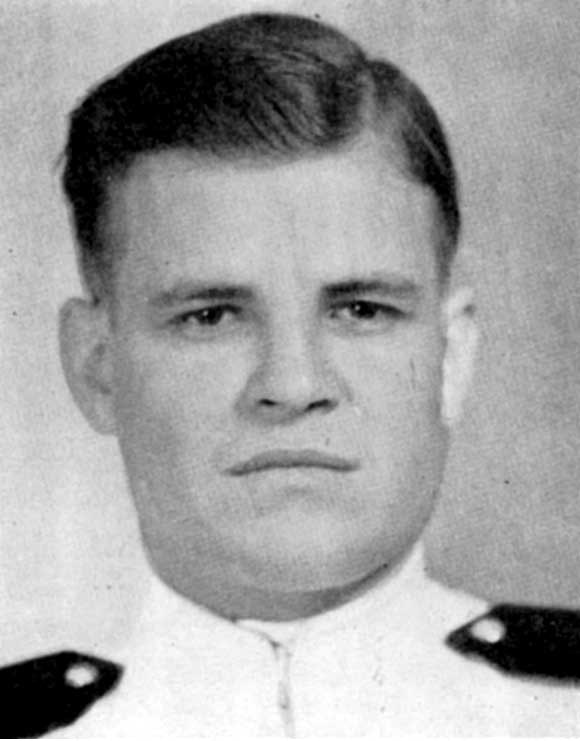Nathan Green Gordon was born on September 4, 1916 in Morrilton, Arkansas. He was a graduate of the Arkansas Polytechnic College (today Arkansas Tech University) and graduated from the University of Arkansas with a law degree in 1939. While in school, he enlisted in the Arkansas National Guard. Gordon was engaged in private law practice when he decided to join the United States Navy in May of 1941.
Gordon was trained as a Naval Aviator, and after receiving his "Wings of Gold" he joined Patrol Squadron 34 (VP-34) in the South Pacific for combat against the Japanese, flying the Consolidated PBY Catalina seaplane. This patrol squadron, who often flew night missions, dubbed themselves the "Black Cats".
On February 15, 1944, the United States Army Air Forces launched a major raid against Japanese installations at Kavieng Harbor, New Ireland in the Bismarck Archipelago. The patrol planes of VP-34 sortied in support. Upon receiving a distress signal that two of the Army bombers were shot down and their crews were adrift, Gordon piloted his Catalina repeatedly through enemy fires, executing three water-borne landings, to rescue them before they could be killed or captured by the Japanese.
Gordon had nicknamed his plane the Arkansas Traveler. The seven members of her crew received the Silver Star for the rescues. Her aircraft commander received the Medal of Honor.
From Medal of Honor Citations for World War II (G-L):
GORDON, NATHAN GREEN
Rank and organization: Lieutenant, U.S. Navy, commander of Catalina patrol plane
Place and date: Bismarck Sea, 15 February 1944
Entered service at: Arkansas.
Citation: For extraordinary heroism above and beyond the call of duty as commander of a Catalina patrol plane in rescuing personnel of the U.S. Army 5th Air Force shot down in combat over Kavieng Harbor in the Bismarck Sea, 15 February 1944. On air alert in the vicinity of Vitu Islands, Lt. (then Lt. j.g.) Gordon unhesitatingly responded to a report of the crash and flew boldly into the harbor, defying close-range fire from enemy shore guns to make 3 separate landings in full view of the Japanese and pick up 9 men, several of them injured. With his cumbersome flying boat dangerously overloaded, he made a brilliant takeoff despite heavy swells and almost total absence of wind and set a course for base, only to receive the report of another group stranded in a rubber life raft 600 yards from the enemy shore. Promptly turning back, he again risked his life to set his plane down under direct fire of the heaviest defenses of Kavieng and take aboard 6 more survivors, coolly making his fourth dexterous takeoff with 15 rescued officers and men. By his exceptional daring, personal valor, and incomparable airmanship under most perilous conditions, Lt. Gordon prevented certain death or capture of our airmen by the Japanese.
Gordon survived the war, and as his Medal of Honor citation indicates, was promoted to Lieutenant before the award. He entered politics after his discharge from the Navy and was elected to be the Lieutenant Governor of Arkansas. He served ten consecutive two-year terms in that office from 1947-1967.
Coincidentally, the man who followed Gordon as the Lieutenant Governor was Maurice L. Britt, a fellow Medal of Honor recipient from World War II.
In 2003, Gordon recounted the day his heroism and flying skill saved the lives of his Army Air Force colleagues. He passed away four days after his 92nd birthday on September 8, 2008 in Little Rock, Arkansas. Gordon was laid to rest in the Elmwood Cemetery at his birthplace of Morrilton.
"[I]f we fail, then the whole world,…all that we have known and cared for…will sink into the abyss of a new Dark Age made more sinister, and perhaps more protracted, by the lights of perverted science. Let us therefore brace ourselves to our duties, and so bear ourselves that…men will still say, 'This was their finest hour.'”



No comments:
Post a Comment
COMMENTS ARE CLOSED. NO ADDITIONAL COMMENTS WILL BE POSTED HERE. IF YOU WISH TO COMMENT, PLEASE GO TO THE NEW BLOG SITE – http://theirfinesthour.net – AND LEAVE YOUR FEEDBACK THERE!!!
Note: Only a member of this blog may post a comment.